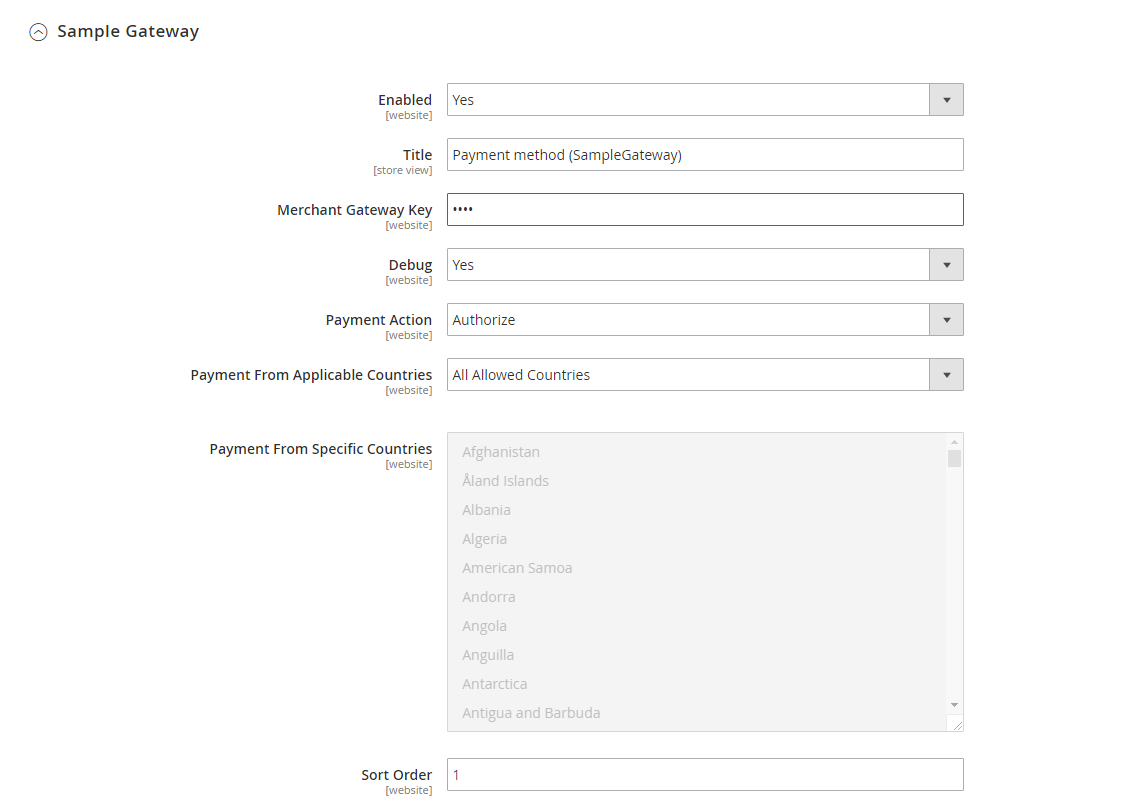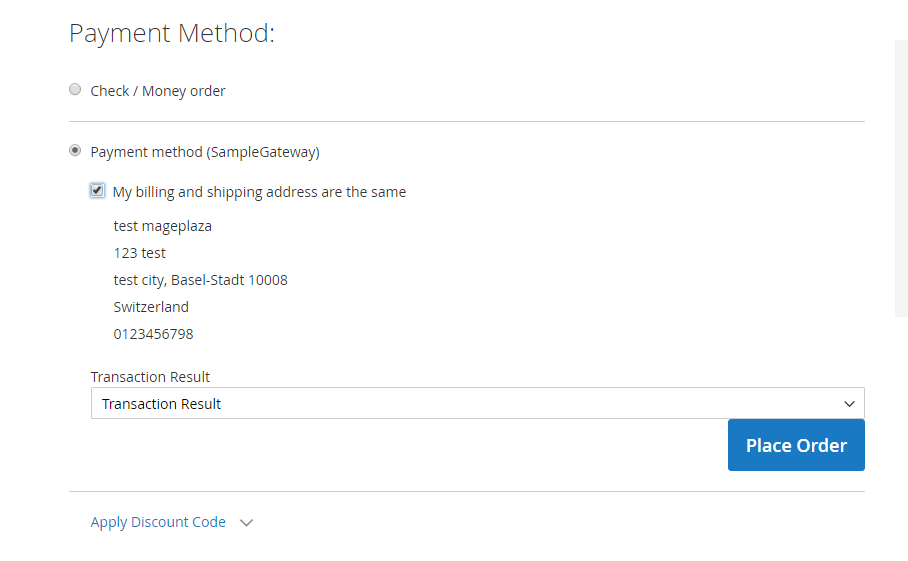Create Payment Method
Magento 2 Create Payment Method proves that store admin like you has rights to generate as many payment methods as you need when your store is based on Magento 2 platform, a great era of ecommerce architecture. Depending on the customer’s requirements, you probably add them to your list of the existing payment method. The additional payment methods surely bring the diversity of customer choice when they proceed to checkout on your site, which can enhance their experience and reduce the abandoned cart rates. On the other hand, offering multiple payment method is the great strategy to reach out to the global marketplace.
In the tutorial, you will learn how to create your own Payment Gateway integration in Magento 2 stores. After launching the new payment methods, you will find and configure it according to the path Admin panel > Stores > Settings > Configuration > Sales > Payment Methods. There, admin possibly assigns a payment method to a specific shipping method, which means they will work in pairs when enabling. It allows better security, better experience and may reduce related fees for you and your customers.
Table of Contents
- Step 1: Create payment method module (Working on Magento 2.0.x)
- Step 2: Declare payment method module
- Step 3: Display payment method in checkout page
Create payment method module (Magento 2.1.x, 2.2.x, +) [UPDATED]
We have updated this post which is working great with Magento 2.1 and Magento 2.2+.
The sample module available here.
After install the sample payment method module, you can see the configuration in Admin panel > Stores > Settings > Configuration > Sales > Payment Methods

In checkout step, you can choose new payment method (gateway): SampleGateway

You may also be interested in Magento 2 Create Shipping Methods to customize the shipping methods as expected.
Step 1: Create payment method module (Working on Magento 2.0.x)
- Create file registration.php
<?php
\Magento\Framework\Component\ComponentRegistrar::register(
\Magento\Framework\Component\ComponentRegistrar::MODULE,
'Mageplaza_Payment',
__DIR__
);
- Declare
module.xmlfile
<?xml version="1.0"?>
<config xmlns:xsi="http://www.w3.org/2001/XMLSchema-instance" xsi:noNamespaceSchemaLocation="urn:magento:framework:Module/etc/module.xsd">
<module name="Mageplaza_Payment" setup_version="0.1.0">
<sequence>
<module name="Magento_Sales"/>
<module name="Magento_Payment"/>
<module name="Magento_Checkout"/>
<module name="Magento_Directory" />
<module name="Magento_Config" />
</sequence>
</module>
</config>
This module have to run after the Magento_Sales, Magento_Payment, Magento_Checkout, Magento_Directory, and Magento_Config. So we add depends (sequence) them like above block of code.
Step 2: Declare payment method module
- Now we create file
payment.xmlfile inetcfolder etc/payment.xml
<?xml version="1.0" ?>
<payment xmlns:xsi="http://www.w3.org/2001/XMLSchema-instance"
xsi:noNamespaceSchemaLocation="urn:magento:module:Magento_Payment:etc/payment.xsd">
<groups>
<group id="offline">
<label>Offline Payment Methods</label>
</group>
</groups>
<methods>
<method name="simple">
<allow_multiple_address>1</allow_multiple_address>
</method>
</methods>
</payment>
- Create
config.xmlfile inetcfolder.
<?xml version="1.0" ?>
<config xmlns:xsi="http://www.w3.org/2001/XMLSchema-instance"
xsi:noNamespaceSchemaLocation="urn:magento:module:Magento_Store:etc/config.xsd">
<default>
<payment>
<simple>
<active>1</active>
<model>Mageplaza\Payment\Model\Payment\Simple</model>
<order_status>pending</order_status>
<title>Simple</title>
<allowspecific>0</allowspecific>
<group>Offline</group>
</simple>
</payment>
</default>
</config>
In this file, we declare Model of this payment method, we calle Simple model.
- Create Simple model file
Create file Model/Payment/Simple.php
<?php
namespace Mageplaza\Payment\Model\Payment;
class Simple extends \Magento\Payment\Model\Method\Cc
{
protected $_isGateway = true;
protected $_canCapture = true;
protected $_canCapturePartial = true;
protected $_canRefund = true;
protected $_canRefundInvoicePartial = true;
protected $_stripeApi = false;
protected $_countryFactory;
protected $_minAmount = null;
protected $_maxAmount = null;
protected $_supportedCurrencyCodes = array('USD');
protected $_debugReplacePrivateDataKeys
= ['number', 'exp_month', 'exp_year', 'cvc'];
public function __construct(\Magento\Framework\Model\Context $context,
\Magento\Framework\Registry $registry,
\Magento\Framework\Api\ExtensionAttributesFactory $extensionFactory,
\Magento\Framework\Api\AttributeValueFactory $customAttributeFactory,
\Magento\Payment\Helper\Data $paymentData,
\Magento\Framework\App\Config\ScopeConfigInterface $scopeConfig,
\Magento\Payment\Model\Method\Logger $logger,
\Magento\Framework\Module\ModuleListInterface $moduleList,
\Magento\Framework\Stdlib\DateTime\TimezoneInterface $localeDate,
\Magento\Directory\Model\CountryFactory $countryFactory,
array $data = array()
) {
parent::__construct(
$context, $registry, $extensionFactory, $customAttributeFactory,
$paymentData, $scopeConfig, $logger, $moduleList, $localeDate, null,
null, $data
);
$this->_countryFactory = $countryFactory;
$this->_minAmount = $this->getConfigData('min_order_total');
$this->_maxAmount = $this->getConfigData('max_order_total');
}
/**
* Authorize payment abstract method
*
* @param \Magento\Framework\DataObject|InfoInterface $payment
* @param float $amount
* @return $this
* @throws \Magento\Framework\Exception\LocalizedException
* @api
* @SuppressWarnings(PHPMD.UnusedFormalParameter)
*/
public function authorize(\Magento\Payment\Model\InfoInterface $payment, $amount)
{
if (!$this->canAuthorize()) {
throw new \Magento\Framework\Exception\LocalizedException(__('The authorize action is not available.'));
}
return $this;
}
/**
* Capture payment abstract method
*
* @param \Magento\Framework\DataObject|InfoInterface $payment
* @param float $amount
* @return $this
* @throws \Magento\Framework\Exception\LocalizedException
* @api
* @SuppressWarnings(PHPMD.UnusedFormalParameter)
*/
public function capture(\Magento\Payment\Model\InfoInterface $payment, $amount)
{
if (!$this->canCapture()) {
throw new \Magento\Framework\Exception\LocalizedException(__('The capture action is not available.'));
}
return $this;
}
/**
* Refund specified amount for payment
*
* @param \Magento\Framework\DataObject|InfoInterface $payment
* @param float $amount
* @return $this
* @throws \Magento\Framework\Exception\LocalizedException
* @api
* @SuppressWarnings(PHPMD.UnusedFormalParameter)
*/
public function refund(\Magento\Payment\Model\InfoInterface $payment, $amount)
{
if (!$this->canRefund()) {
throw new \Magento\Framework\Exception\LocalizedException(__('The refund action is not available.'));
}
return $this;
}
}
This model includes basic functions such as
authorize(): Authorize the payment e.g: cardcapture(): Capture money from a customerrefund(): Chargeback money to the customer.
Step 3: Display payment method in checkout page
In previous steps, we talked about declaring modules, config and model files. Now we need to display this Simple payment method in checkout page.
- Create layout file: view/frontend/layout/checkout_index_index.xml
<?xml version="1.0" ?>
<pagepage layout="1column" xmlns:xsi="http://www.w3.org/2001/XMLSchema-instance"
xsi:noNamespaceSchemaLocation="urn:magento:framework:View/Layout/etc/page_configuration.xsd">
<body>
<referenceBlock name="checkout.root">
<arguments>
<argument name="jsLayout" xsi:type="array">
<item name="components" xsi:type="array">
<item name="checkout" xsi:type="array">
<item name="children" xsi:type="array">
<item name="steps" xsi:type="array">
<item name="children" xsi:type="array">
<item name="billing-step" xsi:type="array">
<item name="children" xsi:type="array">
<item name="payment" xsi:type="array">
<item name="children" xsi:type="array">
<item name="renders" xsi:type="array">
<item name="children" xsi:type="array">
<item name="offline-payments" xsi:type="array">
<item name="component" xsi:type="string">Magento_OfflinePayments/js/view/payment/offline-payments</item>
<item name="methods" xsi:type="array">
<item name="simple" xsi:type="array">
<item name="isBillingAddressRequired" xsi:type="boolean">true</item>
</item>
</item>
</item>
</item>
</item>
</item>
</item>
</item>
</item>
</item>
</item>
</item>
</item>
</item>
</argument>
</arguments>
</referenceBlock>
</body>
</pagepage>
- Create js files to load KO template in checkout page
define(
[
'uiComponent',
'Magento_Checkout/js/model/payment/renderer-list'
],
function (Component,
rendererList) {
'use strict';
rendererList.push(
{
type: 'simple',
component: 'Mageplaza_Payment/js/view/payment/method-renderer/simple-method'
}
);
return Component.extend({});
}
);
In this file, it call another component: js/view/payment/method-renderer/simple-method
Now we need to create /view/frontend/web/js/view/payment/method-renderer/simple-method.js
define(
[
'Magento_Checkout/js/view/payment/default'
],
function (Component) {
'use strict';
return Component.extend({
defaults: {
template: 'Mageplaza_Payment/payment/simple'
},
getMailingAddress: function () {
return window.checkoutConfig.payment.checkmo.mailingAddress;
},
});
}
);
- Finally, create KO template file /view/frontend/web/template/payment/simple.html
<div class="payment-method" data-bind="css: {'_active': (getCode() == isChecked())}">
<div class="payment-method-title field choice">
<input type="radio"
name="payment[method]"
class="radio"
data-bind="attr: {'id': getCode()}, value: getCode(), checked: isChecked, click: selectPaymentMethod, visible: isRadioButtonVisible()"/>
<label data-bind="attr: {'for': getCode()}" class="label"><span data-bind="text: getTitle()"></span></label>
</div>
<div class="payment-method-content">
<!-- ko foreach: getRegion('messages') -->
<!-- ko template: getTemplate() --><!-- /ko -->
<!--/ko-->
<div class="payment-method-billing-address">
<!-- ko foreach: $parent.getRegion(getBillingAddressFormName()) -->
<!-- ko template: getTemplate() --><!-- /ko -->
<!--/ko-->
</div>
<div class="checkout-agreements-block">
<!-- ko foreach: $parent.getRegion('before-place-order') -->
<!-- ko template: getTemplate() --><!-- /ko -->
<!--/ko-->
</div>
<div class="actions-toolbar">
<div class="primary">
<button class="action primary checkout"
type="submit"
data-bind="
click: placeOrder,
attr: {title: $t('Place Order')},
css: {disabled: !isPlaceOrderActionAllowed()},
enable: (getCode() == isChecked())
"
disabled>
<span data-bind="i18n: 'Place Order'"></span>
</button>
</div>
</div>
</div>
</div>
Sample Payment method module
The bottom line
Creating payment methods is an essential step for online businesses to make, as multiple payment options can increase conversion rates and create extra sales, not to mention global reach. That is why you should take this into account now for better business operations. And it is not as difficult as you may think it is, right?
Happy coding and enjoy your extra sales!
Any questions? Feel free to leave a comment.
Explore Mageplaza Payment Suite for better payment method control
Related Post
Enjoyed the tutorial? Spread it to your friends!

Sam Thomas
CEO and Founder of Mageplaza. Pursueing a simple and healthy lifestyle. A friend, a husband and a dad of two children, a trainer and an influencer wannabe. He is a big fan of sports and travel, also.
Featured Extensions



People also searched for
- magento 2 create payment method
- magento 2 custom payment method
- magento 2 create custom payment method
- create payment method magento 2
- magento 2 create new payment method
- create custom payment method in magento 2
- custom payment method in magento 2
- magento 2 add payment method
- create payment method in magento 2
- custom payment method magento 2
- payment method magento 2
- magento 2 add new payment method
- add payment method magento 2
- magento custom payment method
- magento 2 payment method
- magento 2 create online payment method
- magento 2 custom credit card payment method
- magento 2 add custom payment method
- magento 2 payment methods
- magento 2 new payment method
- magento custom payment gateway
- magento 2 payment module
- magento 2 custom payment gateway
- payment method in magento 2
- magento payment methods
- magento 2 admin payment method
- magento 2 payment gateway tutorial
- magento 2 create offline payment method
- magento 2 set payment method programmatically
- 2.2.x, 2.3.x, 2.4.x
